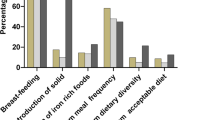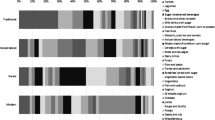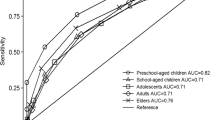Abstract
Background/Objectives:
Dietary diversity is associated with overall quality and nutrient adequacy of the diet in low-income countries. We determined the association between dietary diversity and stunting among children aged 6–59 months in rural Bangladesh.
Subjects/Methods:
In total, 165 111 under-fives who participated in the National Surveillance Project in 2003–2005 were included in the analysis. Dietary diversity score (DDS) was constructed through the summation of the number of days each of the nine food groups was consumed in the previous week. The association between stunting and DDS was determined adjusting for confounders using logistic regression models. All analyses were performed separately for children aged 6–11, 12–23 and 24–59 months.
Results:
One-half of the children were stunted. In multivariate analyses, compared with low DDS, high dietary diversity was associated with a 15, 26 and 31% reduced odds of being stunted among children aged 6–11, 12–23 and 24–59 months, respectively, after adjusting for all potential confounders (odds ratio (OR)=0.85, 95% confidence interval (CI): 0.76–0.94; OR=0.74, 95% CI: 0.69–0.79; OR=0.69, 95% CI: 0.66–0.73). In all groups, children who were still breastfed were more likely to have limited diversity (OR=1.88, 95% CI: 1.32–2.67; OR=1.71, 95% CI: 1.52–1.92; OR=1.15, 95% CI: 1.11–1.19). Those having diarrhea in the past week and coming from families with low socioeconomic status were more likely to have decreased diversity (P<0.05).
Conclusions:
Reduced dietary diversity is a strong predictor of stunting in rural Bangladesh. The inclusion of a variety of food groups into complementary foods may be essential to improve child nutritional status.
This is a preview of subscription content, access via your institution
Access options
Subscribe to this journal
Receive 12 print issues and online access
$259.00 per year
only $21.58 per issue
Buy this article
- Purchase on Springer Link
- Instant access to full article PDF
Prices may be subject to local taxes which are calculated during checkout

Similar content being viewed by others
References
Arimond M, Ruel MT (2004). Dietary diversity is associated with child nutritional status: evidence from 11 demographic and health surveys. J Nutr 134, 2579–2585.
Bloem MW, Moench-Pfanner R, Panagides D (2003). Health and Nutritional Surveillance for Development. Helen Keller Worldwide: Singapore.
de Pee S, Bloem MW (2001). Assessing and communicating the impact of nutrition and health programs. In: Semba RD, Bloem MW (eds). Nutrition and Health in Developing Countries. Human Press: Totowa, NJ. pp 483–506.
Gibson RS (1990). Principles of Nutritional Assessment. Oxford University Press: New York.
Hatloy A, Torheim LE, Oshaug A (1998). Food variety—a good indicator of nutritional adequacy of the diet? A case study from an urban area in Mali, West Africa. Eur J Clin Nutr 52, 891–898.
Kennedy GL, Pedro MR, Seghieri C, Nantel G, Brouwer I (2007). Dietary diversity score is a useful indicator of micronutrient intake in non-breast-feeding Filipino children. J Nutr 137, 472–477.
Martorell R, Delgado H, Valverde V, Klein RE (1981). Maternal stature, fertility, and infant mortality. Hum Biol 53, 303–312.
Martorell R, Khan LK, Schroeder DG (1994). Reversibility of stunting: epidemiological findings in children from developing countries. Eur J Clin Nutr 48, S45–S57.
Measure DHS (2007). Demographic and Health Surveys. Bangladesh. Internet:http://www.measuredhs.com/pubs/pdf/FR207/FR207[April-10-2009].pdf(accessed 13 April 2010).
Pollitt E, Gorman KS, Engle PL, Rivera JA, Martorell R (1995). Nutrition in early life and the fulfilment of intellectual potential. J Nutr 125, S1111–S1118.
Ruel MT (2003). Is dietary diversity an indicator of food security or dietary quality? A review of measurement issues and research needs. Food Nutr Bull 24, 231–232.
Sawadogo PS, Martin-Prevel Y, Savy M, Kameli Y, Traissac P, Traore AS et al. (2006). An infant and child feeding index is associated with the nutritional status of 6- to 23-month-old children in rural Burkina Faso. J Nutr 136, 656–663.
Shafique S, Akhter N, Stallkamp G, de Pee S, Panagides D, Bloem MW (2007). Trends of under- and overweight among rural and urban poor women indicate the double burden of malnutrition in Bangladesh. Int J Epidemiol 36, 449–457.
Steyn NP, Nel JH, Nantel G, Kennedy GL, Labadarios D (2006). Food variety and dietary diversity scores in children: are they good indicators of dietary adequacy? Public Health Nutr 9, 644–650.
Thorne-Lyman AL, Valpiani N, Sun K, Semba RD, Klotz CL, Kraemer K et al. (2010). Household dietary diversity and food expenditures are closely linked in rural Bangladesh, increasing the risk of malnutrition due to the financial crisis. J Nutr 140, 182S–188S.
Torheim LE, Ouattara F, Diarra MM, Thiam FD, Barikmo I, Hatloy A et al. (2004). Nutrient adequacy and dietary diversity in rural Mali: association and determinants. Eur J Clin Nutr 58, 594–604.
United Nations Children's Fund (2008). The State of the World's Children 2009. UNICEF: New York.
Victora CG (1992). The association between wasting and stunting: an international perspective. J Nutr 122, 1105–1110.
Victora CG, Adair L, Fall C, Hallal PC, Martorell R, Richter L et al. (2008). Maternal and child undernutrition: consequences for adult health and human capital. Lancet 371, 340–357.
Waterlow JC (1994). Summary of causes and mechanisms of linear growth retardation. Eur J Clin Nutr 48, S75–S89.
World Health Organization (2006). WHO Child Growth Standards: Methods and Development. World Health Organization: Geneva.
Zhang J, Shi L, Wang J, Wang Y (2009). An infant and child feeding index is associated with child nutritional status in rural China. Early Hum Dev 85, 247–252.
Author information
Authors and Affiliations
Corresponding author
Ethics declarations
Competing interests
The authors declare no conflict of interest.
Rights and permissions
About this article
Cite this article
Rah, J., Akhter, N., Semba, R. et al. Low dietary diversity is a predictor of child stunting in rural Bangladesh. Eur J Clin Nutr 64, 1393–1398 (2010). https://doi.org/10.1038/ejcn.2010.171
Received:
Revised:
Accepted:
Published:
Issue Date:
DOI: https://doi.org/10.1038/ejcn.2010.171
Keywords
This article is cited by
-
Adherence to dietary guidelines associated with lower medical service utilization in preschoolers: a longitudinal study
Nutrition & Diabetes (2024)
-
Trends in and predictors of animal source food consumption among 6–23 months age children in Tigrai, Northern Ethiopia: evidence from three consecutive ethiopian demographic and health surveys, EDHS 2005–2016
BMC Nutrition (2023)
-
Income-Nutrition Gradient and Intrahousehold Allocation in Rural Pakistan
Maternal and Child Health Journal (2023)
-
The effect of the local environment on child nutritional outcomes: how does seasonality relate to wasting amongst children under 5 in south-west coastal Bangladesh?
Population and Environment (2023)
-
Association between dietary diversity and nutritional status of the children aged 6–23 months in Bangladesh: evidence from the Multiple Indicator Cluster Survey 2019
Nutrire (2022)



